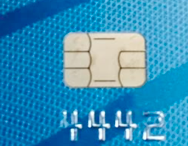:
Introduction to Europay, Mastercard, and Visa
Over the last year, we're sure that you have heard more about EMV than anything else. Though many have heard about EMV, few really understand how EMV will affect business.
Understanding
: What does EMV Stand for? EMV is an abbreviation for Europay Mastercard and Visa. Those are the 3 organizations that developed the initial specifications for this technology (Clients are not limited to those 3 options.) How does EMV look? EMV enabled cards to have a small gold chip on the bottom left-hand corner (see below)

How does EMV work?
First, the purpose of EMV is to protect the cardholders and merchants from fraudulent transactions. EMV enabled cards to provide each transaction with a uniquely encrypted code making it virtually impossible to counterfeit cards. EMV is slow in transition at this point. According to an Aug 17th article by Pymnts.com
, A recent poll indicates that only one in 10 Americans reported receiving chip-enabled cards. That poll of about 1,000 people was conducted by GfK Public Affairs for the Associated Press. The poll further found that among the 10 percent who are holding EMV cards only 35 percent confirmed actually using their card in a chip card reader, while another 30 percent admitted they were unsure exactly how to use the new card.” On October 1st the responsibility for fraudulent transactions will shift to the Retailer or Processor instead of the Banks (whichever of the two parties is least prepared to accept EMV).
PCI along with EMV
:
Generally, retailers believe PCI compliance requires EMV use. That is false. While the two work hand and hand to protect against fraud, they are different and PCI compliance does not require EMV. The difference between the two is EMV helps merchants identify and protect the possible use of counterfeit credit cards. PCI compliance helps merchants safeguard physical and digital data security-related infringements along their entire processing and payment network.
Liabilities
:
While retailers are not expected to stop accepting standard magstripe cards due to the small percentage of consumers with EMV enabled cards, not being prepared to accept EMV will generally make the retailer liable.
Counterfeit Transactions
:
Example 1
: If the processor & retailer are not equipped to accept EMV and a counterfeit transaction is processed, the retailer is generally not liable like normal.
Example 2
: If the processor is equipped to accept EMV but the retailer has not invested in the upgrade, the retailer is generally liable
Example 3
: If both the processor & the retailer are equipped to accept EMV, the processor will continue to be liable.
NOTE
:
Cited from an Infographic from Visa
- “The EMV liability shift does not apply to card-not-present transactions, lost and stolen fraud. In these cases, the liability remains subject to existing liability and chargeback rules.“